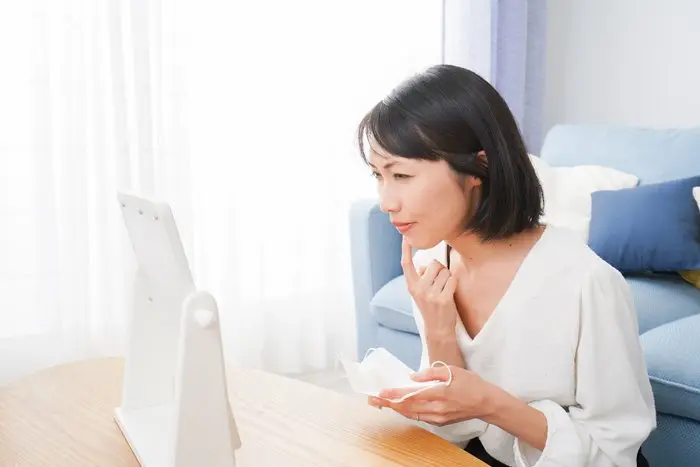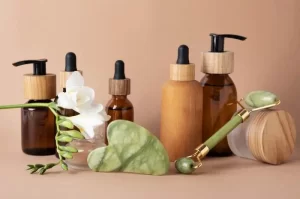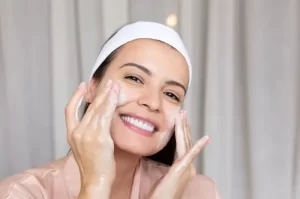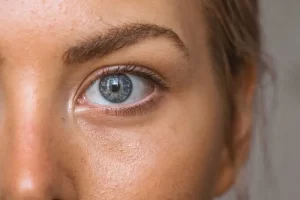The world of skincare has been revolutionized by the influence of Korean beauty, commonly known as K-beauty. This phenomenon, originating from South Korea, has become globally recognized for its innovative products, unique ingredients, and most importantly, its effective skincare philosophies.
Unlike Western approaches that often prioritize quick fixes, K-beauty is renowned for its emphasis on a holistic and preventative approach to skin health. This is particularly evident in how K-beauty tackles a common skin concern: acne.
Acne, a widespread issue affecting people of all ages, can be particularly challenging to manage. Traditional treatments often involve harsh chemicals and aggressive methods that might offer temporary relief but fail to address underlying skin health.
This is where K-beauty steps in with a refreshing perspective. Rooted in centuries-old traditions and modern dermatological science, K-beauty approaches acne treatment not just as a problem to be eradicated, but as a sign of deeper imbalances within the skin.
K-beauty’s acne treatment strategy is comprehensive, gentle, and focused on nurturing the skin back to health. It relies on innovative formulations that combine natural ingredients known for their healing properties with cutting-edge skincare technology. This approach ensures that while the immediate concerns of acne are addressed, the skin’s long-term health is also nurtured.
In this article, we delve into the K-beauty way of treating acne. From understanding the philosophy behind Korean skincare to exploring key ingredients and effective routines, we will guide you through everything you need to know to incorporate this approach into your skincare regime.
Whether you are a longtime sufferer of acne or just looking for a more skin-friendly way to manage occasional breakouts, the Korean beauty method offers a gentle yet effective pathway to clear, healthy skin.
Understanding Korean Beauty Philosophy
The Korean beauty philosophy stands distinct in the global skincare landscape, characterized by its holistic approach and its meticulous attention to skin health and prevention.
At its core, K-beauty is not just about treating existing skin issues but is more focused on preventing them before they start. This preventive approach to skincare, especially in managing acne, sets K-beauty apart from many Western skincare strategies.
Emphasis on Skin Health and Balance
Korean beauty principles stem from the age-old belief that skin health is a reflection of overall well-being. This philosophy emphasizes maintaining a balance, not only in the skin’s condition but in one’s lifestyle as well.
Stress, diet, and sleep patterns are all considered crucial factors that affect skin health. The K-beauty approach encourages a harmonious balance between external skincare and internal health.
Gentle and Nurturing Approach
Korean skincare is renowned for being gentle and nurturing. Unlike aggressive treatments that strip the skin of its natural oils, K-beauty products aim to gently nourish and heal. This is particularly important for acne-prone skin, which can be sensitive and easily irritated.
By using soothing and healing ingredients, K-beauty helps to calm inflammation, reduce redness, and prevent scarring, all without over-drying the skin.
Layering and Customization
A hallmark of Korean skincare is the concept of layering multiple products. Each step in the skincare routine serves a specific purpose, from deep cleansing to intensive hydration. For acne-prone skin, this allows for a highly customized approach.
Individuals can choose products with ingredients that target acne specifically at each step, creating a tailored routine that addresses their unique skin concerns.
Innovative Ingredients and Formulations
Korean beauty is at the forefront of cosmetic innovation, constantly incorporating new, often natural, ingredients into its products. Ingredients like snail mucin, bee venom, and fermented extracts are just a few examples that have been popularized by K-beauty.
For acne treatment, ingredients are chosen for their abilities to reduce inflammation, fight bacteria, and promote skin healing.
Patience and Consistency
Finally, the Korean beauty philosophy emphasizes patience and consistency. Achieving healthy, clear skin is viewed as a journey, not a quick fix.
This approach is particularly beneficial for treating acne, as it encourages the consistent use of gentle, nurturing products rather than seeking immediate, potentially damaging solutions.
Key Ingredients in K-Beauty for Acne
The effectiveness of Korean beauty in treating acne largely hinges on the unique and innovative ingredients used in its products. These ingredients are carefully selected for their ability to combat acne while nurturing the skin. Here’s an overview of some key ingredients commonly found in K-beauty products that are beneficial for acne-prone skin:
Tea Tree Oil
Tea tree oil is renowned for its antibacterial and anti-inflammatory properties. It’s a staple in K-beauty for treating acne because it effectively combats acne-causing bacteria and reduces inflammation, making it ideal for both treating active breakouts and preventing new ones.
Snail Mucin
While it may sound unconventional, snail mucin is a celebrated ingredient in Korean skincare. It’s known for its healing properties, helping to repair skin damage, soothe inflammation, and hydrate the skin. Its regenerative properties are particularly beneficial for acne scars and hyperpigmentation.
Centella Asiatica
Also known as Cica, this plant extract is a favorite in K-beauty for its soothing and healing properties. It’s excellent for calming inflamed and irritated skin, reducing redness, and promoting skin healing, which is crucial for acne-prone skin.
Niacinamide
Niacinamide, or Vitamin B3, is praised for its ability to regulate oil production, reduce pore size, and diminish redness and inflammation. It’s also effective in improving the skin’s barrier function, which can prevent future breakouts.
Salicylic Acid
A beta-hydroxy acid (BHA) known for its ability to deeply penetrate pores and exfoliate the skin, salicylic acid is key in preventing pore clogging and treating existing acne. It’s a common ingredient in K-beauty products for its effectiveness in clearing out excess sebum and dead skin cells.
Propolis
Derived from bees, propolis is valued for its anti-inflammatory and antibacterial qualities. It works wonders in soothing irritated skin, healing blemishes, and providing antioxidant protection.
Green Tea
Green tea is packed with antioxidants and has anti-inflammatory properties, making it perfect for calming acne-prone skin. It also helps reduce sebum production, which can decrease the likelihood of future breakouts.
Hyaluronic Acid
While not directly an acne treatment, hyaluronic acid is crucial in K-beauty for maintaining skin hydration. Properly hydrated skin can better fight off acne and heal more effectively, making hyaluronic acid an essential ingredient in a balanced skincare routine.
Step-by-Step K-Beauty Routine for Acne-Prone Skin
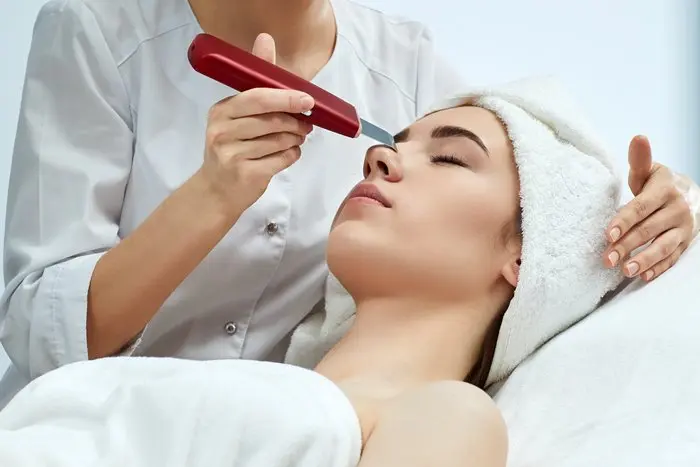
Adopting a Korean beauty routine for acne-prone skin involves multiple steps, each designed to address specific skin needs while nurturing and protecting the skin. Here’s a step-by-step guide to a K-beauty routine tailored for those dealing with acne:
Step 1: Double Cleansing
- Oil Cleanser: Start with an oil-based cleanser to dissolve sebum, makeup, and sunscreen. For acne-prone skin, look for lightweight oils that won’t clog pores.
- Foam Cleanser: Follow with a water-based cleanser to remove water-based impurities like sweat and dirt. A gentle, low pH cleanser is ideal to avoid stripping the skin’s natural oils.
Step 2: Exfoliation (2-3 times a week)
Use a chemical exfoliant containing BHA (like salicylic acid) to penetrate deep into the pores and remove dead skin cells. This helps in preventing pore clogging and reducing existing acne. Be gentle and avoid over-exfoliation to prevent skin irritation.
Step 3: Toner
Apply a hydrating, soothing toner to balance the skin’s pH and hydrate the skin. Look for toners with ingredients like green tea or centella asiatica, which calm inflammation and redness.
Step 4: Essence
Essence is the heart of K-beauty, aimed at hydrating and repairing the skin. Choose an essence with snail mucin or hyaluronic acid for healing and deep hydration.
Step 5: Treatment (Serums and Ampoules)
Apply a treatment product targeting acne. Look for serums or ampoules with tea tree oil, niacinamide, or propolis. These concentrated products can effectively target acne, reduce sebum production, and fade acne scars.
Step 6: Sheet Mask (optional, 1-2 times a week)
Use a sheet mask to provide concentrated hydration and active ingredients. Choose masks formulated for acne-prone skin with soothing and anti-inflammatory ingredients.
Step 7: Moisturizer
Seal in the moisture with a lightweight, non-comedogenic moisturizer. Gel-type or water-based moisturizers are preferable for acne-prone skin, as they hydrate without being too heavy.
Step 8: Sun Protection (in the AM)
Finish with a broad-spectrum sunscreen during the day. Sunscreen not only protects the skin from UV damage but also prevents post-acne marks from darkening.
Additional K-Beauty Practices for Acne Management
While the basic skincare routine is fundamental in Korean beauty philosophy, there are additional practices and tips that can significantly enhance acne management. These practices are designed to complement the daily routine, offering targeted treatments and holistic approaches to skin health.
Regular Sheet Masking
- Purpose: Sheet masks are a staple in K-beauty for delivering concentrated active ingredients to the skin. For acne-prone skin, choose masks with soothing and anti-inflammatory ingredients like aloe vera, green tea, or tea tree extract.
- Frequency: Incorporate sheet masks into your routine 1-2 times per week. This can provide an extra boost of hydration and targeted care for acne.
Spot Treatments
- Localized Care: Spot treatments are highly concentrated products applied directly to blemishes. Ingredients like salicylic acid, sulfur, or calamine are effective in reducing inflammation and speeding up the healing process of pimples.
- Application: Apply spot treatments after your serum step, focusing only on areas with active breakouts.
Weekly Gentle Exfoliation
- Importance: Regular exfoliation helps prevent dead skin cells from clogging pores, a primary cause of acne. However, it’s crucial to be gentle to avoid irritating the skin.
- Method: Opt for chemical exfoliants (like AHAs or BHAs) rather than physical scrubs, as they are less abrasive. Limit exfoliation to 2-3 times a week.
Facial Massages
- Benefits: Facial massages can improve blood circulation, aid in lymphatic drainage, and reduce stress, which is often a contributing factor to acne.
- Technique: Use gentle upward strokes with your fingers or a jade roller. Ensure your hands or tools are clean to avoid transferring bacteria to the skin.
Diet and Lifestyle
- Holistic Approach: K-beauty recognizes the impact of diet and lifestyle on skin health. A balanced diet, rich in fruits, vegetables, and antioxidants, and adequate water intake can positively affect skin health.
- Stress Management: Practices like meditation, adequate sleep, and regular exercise can help manage stress levels, thereby potentially reducing acne flare-ups.
Patience and Consistency
- Long-term Approach: Acne management is a gradual process. Results from a K-beauty routine may take time to become evident. Consistency and patience are key.
- Adaptation: Be prepared to adapt your routine as your skin changes or as you discover which ingredients and products work best for you.
Common Mistakes to Avoid
While adopting a Korean beauty routine for acne-prone skin can be highly beneficial, there are common pitfalls that can inadvertently exacerbate skin issues. Being aware of these mistakes is crucial for ensuring the effectiveness of your skincare regimen and for avoiding any potential harm to your skin.
Over-Exfoliation
- Issue: Exfoliating too frequently or using harsh scrubs can strip the skin of its natural oils and damage the skin barrier, leading to increased sensitivity and irritation.
- Solution: Limit chemical exfoliation to 2-3 times per week and avoid physical exfoliants with rough particles. Pay attention to how your skin reacts and adjust accordingly.
Using Products Not Suited for Acne-Prone Skin
- Issue: Not all K-beauty products are suitable for acne-prone skin. Some may contain comedogenic ingredients that can clog pores or be too rich and heavy.
- Solution: Opt for non-comedogenic, lightweight formulations and be vigilant about ingredient lists. Look for products specifically designed for acne-prone or sensitive skin.
Overloading the Skin with Too Many Products
- Issue: The multi-step K-beauty routine can lead to the temptation to use too many products, overwhelming the skin and potentially causing breakouts.
- Solution: Start with a basic routine and gradually introduce new products. It’s important to let your skin adjust and to identify how each product affects your skin.
Neglecting Hydration
- Issue: Focusing solely on acne treatment and neglecting hydration can lead to dehydrated skin, which can actually worsen acne.
- Solution: Ensure your routine includes hydrating steps, even if you have oily or acne-prone skin. Ingredients like hyaluronic acid can provide hydration without causing breakouts.
Inconsistent Routine
- Issue: Not sticking to a consistent skincare routine can hinder the effectiveness of the products and delay results.
- Solution: Consistency is key in skincare. Establish a routine you can follow daily, and be patient to see results.
Ignoring Internal Factors
- Issue: Acne is not just influenced by external factors; internal aspects like diet, stress, and hormonal imbalances play a significant role.
- Solution: Adopt a holistic approach to skincare. Pay attention to your diet, stress levels, sleep quality, and overall health.
Picking or Squeezing Pimples
- Issue: Picking at acne can cause scarring, spread bacteria, and worsen the breakout.
- Solution: Resist the urge to pick or squeeze. If necessary, use a gentle spot treatment and let it work its magic.
Conclusion
The Korean beauty approach to treating acne represents a thoughtful and comprehensive method that goes beyond mere surface-level treatment. By embracing a philosophy that prioritizes skin health and balance, K-beauty offers a gentle yet effective pathway to managing acne. Its emphasis on layering nurturing ingredients, focusing on prevention, and customizing skincare routines to individual needs sets it apart in the skincare world.
The effectiveness of the Korean beauty approach lies in its holistic consideration of skin health. It’s not just about treating acne but about nurturing the skin back to a state of balance and health. This involves understanding the specific needs of acne-prone skin, choosing the right ingredients, and being consistent and patient with the skincare regimen.
Adopting the K-beauty way for acne treatment encourages a more mindful approach to skincare. It’s about listening to your skin, treating it with care, and being patient as it heals. While results may not be immediate, the gradual improvement in skin health and appearance is a testament to the efficacy of this approach.
